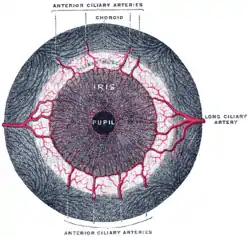Long posterior ciliary arteries
The long posterior ciliary arteries are arteries of the head arising, together with the other ciliary arteries, from the ophthalmic artery. There are two in each eye.
| Long posterior ciliary arteries | |
|---|---|
 | |
 Iris, front view. | |
| Details | |
| Source | ophthalmic artery |
| Supplies | iris ciliary body choroid |
| Identifiers | |
| Latin | Arteriae ciliares posteriores longae |
| TA98 | A12.2.06.032 |
| TA2 | 4481 |
| FMA | 70778 |
| Anatomical terminology | |
Course
They pierce the posterior part of the sclera at some little distance from the optic nerve, and run forward, along either side of the eyeball, between the sclera and choroid, to the ciliary muscle, where they divide into two branches.
These form an arterial circle, the circulus arteriosus major, around the circumference of the iris, from which numerous converging branches run, in the substance of the iris, to its pupillary margin, where they form a second (incomplete) arterial circle, the circulus arteriosus minor.
Target
The long posterior ciliary arteries supply the iris, ciliary body and choroid.
See also
References
This article incorporates text in the public domain from page 571 of the 20th edition of Gray's Anatomy (1918)
External links